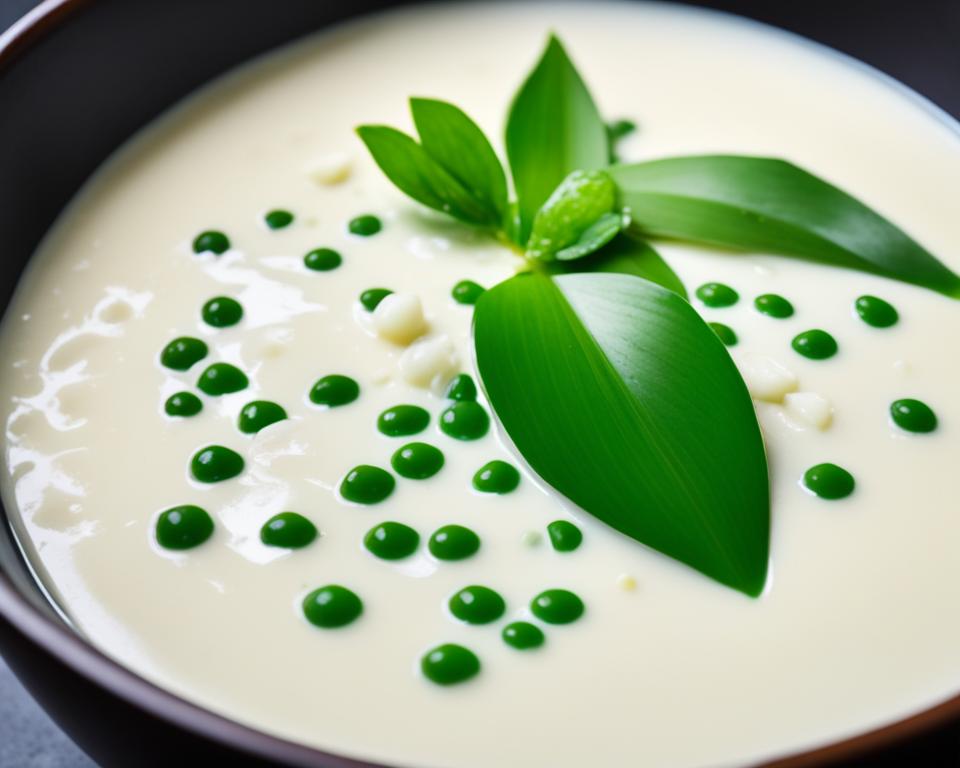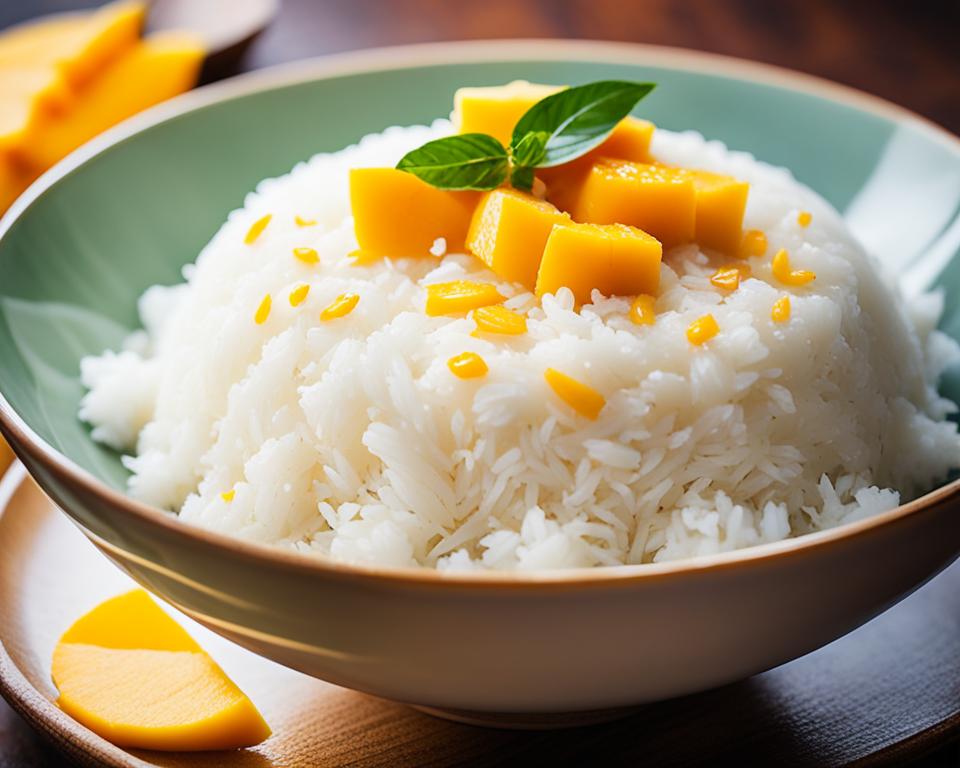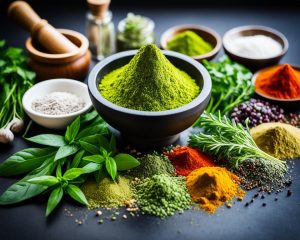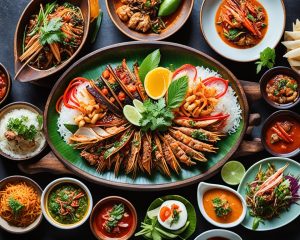Welcome to our article highlighting the deliciousness of authentic mango sticky rice, a beloved Thai dessert. This delightful treat combines the sweetness of ripe mango slices with the creamy richness of sweet coconut milk and the unique texture of sticky rice.
Every bite of this sublime dessert will transport you straight to the vibrant streets of Thailand, where the scent of mangoes fills the air. Whether you’ve experienced the authentic flavors of mango sticky rice before or are eager to try it for the first time, this article will guide you through the traditional recipe, offering insights into the key ingredients, the role of sticky rice, and the art of preparing fresh mango slices.
So, grab a spoon and get ready to dive into the world of authentic mango sticky rice, where every mouthful is a symphony of tropical flavors!
Read more interesting information at ::blackcerenity
What is Mango Sticky Rice?
Mango Sticky Rice is a well-known Thai dessert that combines the natural sweetness of mangoes with the delightful stickiness of glutinous rice. This traditional recipe has been enjoyed by generations, making it a beloved part of Thai cuisine.
Thai desserts are famous for their unique blend of flavors and the way they incorporate local ingredients. Mango Sticky Rice, or “Khao Niao Mamuang” in Thai, perfectly exemplifies this culinary tradition.
“Mango Sticky Rice is a harmonious marriage of soft, sweet mangoes, chewy sticky rice, and a generous drizzle of heavenly sweet coconut milk.”
The mouthwatering combination of textures and flavors makes Mango Sticky Rice a standout dessert that has gained popularity not only in Thailand but around the world. The simplicity of the dish, coupled with its indulgent taste, has made it a staple in Thai restaurants and a must-try for dessert enthusiasts.
To appreciate the true essence of Mango Sticky Rice, it is important to understand its traditional recipe. The recipe typically involves cooking glutinous rice until it reaches a sticky and slightly chewy consistency. The rice is then infused with a mixture of coconut milk, sugar, and salt, giving it a creamy and subtly sweet flavor.
Once the sticky rice is ready, it is served alongside fresh, ripe mango slices. The vibrant yellow mangoes provide a burst of freshness and a contrasting tanginess that balances the sweetness of the coconut-infused rice. The result is a delectable dessert that satisfies both the palate and the senses.
Why is Mango Sticky Rice So Popular?
Mango Sticky Rice has captured the hearts and taste buds of people worldwide for several reasons:
- The perfect balance of sweetness and creaminess appeals to a wide range of dessert enthusiasts.
- The simplicity of the recipe allows the natural flavors of the ingredients to shine.
- Mango Sticky Rice can be enjoyed both warm or chilled, making it a versatile dessert for any occasion.
- The combination of sticky rice, coconut milk, and mangoes creates a delightful contrast of textures.
- It provides a delicious taste of Thai culture and cuisine.
No matter where you are in the world, indulging in a plate of Mango Sticky Rice will transport you to the vibrant streets of Thailand.
| Benefits of Mango Sticky Rice | Nutritional Content |
|---|---|
| 1. Rich in Vitamins A and C | • Mangoes are packed with antioxidants and vitamin C, boosting the immune system and supporting skin health. |
| 2. High in Fiber | • Sticky rice provides dietary fiber, aiding digestion and promoting a healthy gut. |
| 3. Natural Energy Source | • The combination of glutinous rice and mangoes offers a source of energy, perfect for active individuals. |
| 4. Heart-Healthy | • Coconut milk used in the recipe contains heart-healthy fats that may help reduce the risk of cardiovascular diseases. |
Key Ingredients for Authentic Mango Sticky Rice
Creating the perfect mango sticky rice requires a careful selection of key ingredients to capture the traditional flavors and textures of this beloved Thai dessert. Let’s explore the essential components that make up this delightful treat.
Mango
The star of the dish, the mango, should be ripe, fragrant, and full of sweetness. Look for mangoes that are slightly soft to the touch and have a vibrant color. The popular varieties used in mango sticky rice include Honey Mango (also known as Ataulfo) and Champagne Mango (also known as Kent).
Sticky Rice (Glutinous Rice)
Sticky rice, also known as glutinous rice, is the foundation of this dessert. It has a unique sticky texture that ensures the rice clings together, allowing it to be easily enjoyed with the mango and coconut milk. It is essential to use this specific type of rice to achieve the desired consistency. Regular long-grain rice will not work for this recipe.
Coconut Milk
Coconut milk is a key ingredient that adds a rich and creamy flavor to mango sticky rice. It is made by squeezing the liquid from grated coconut flesh, resulting in a silky texture and a hint of natural sweetness. Look for high-quality canned or fresh coconut milk to enhance the overall taste of the dessert.
Sugar
Sugar is used to sweeten the sticky rice and coconut milk mixture. The amount can vary depending on personal preference. It is common to use white or palm sugar, which adds a subtle caramel-like flavor to the dessert.
Salt
A pinch of salt is added to the sticky rice to balance the sweetness of the coconut milk and mango. It helps enhance the flavors and creates a harmonious taste profile.
Sesame Seeds
Sesame seeds are often sprinkled on top of the assembled dessert, adding a nutty crunch and additional visual appeal to the dish. They provide a delightful contrast to the creamy texture of the mango sticky rice.
By using these traditional ingredients, you can create an authentic mango sticky rice that captures the essence of this popular Thai dessert. The combination of ripe mango slices, sticky rice infused with coconut milk, and the delicate balance of sweetness and texture make for an unforgettable culinary experience.
The Role of Sticky Rice in the Recipe
In the traditional recipe of delicious mango sticky rice, sticky rice plays a crucial role in creating the unique texture and flavor that make this Thai dessert so enticing. Sticky rice, also known as glutinous rice, is a staple ingredient in many Southeast Asian cuisines, including Thailand. It gets its “sticky” characteristic from the high levels of amylopectin, a type of starch that gives the rice its distinctive chewiness and stickiness when cooked.
When combined with the other ingredients in the mango sticky rice recipe, sticky rice becomes the foundation of this delectable dessert. During the cooking process, the sticky rice absorbs the sweet coconut milk, which infuses it with a creamy, aromatic flavor. The naturally sticky nature of the rice creates a delightful, slightly chewy texture that contrasts beautifully with the tender and juicy mango slices.
To prepare sticky rice for mango sticky rice, it is essential to soak the rice beforehand to ensure even cooking. The rice is then steamed, allowing it to soften while maintaining its sticky consistency. This careful cooking method ensures that the rice retains its distinct texture and doesn’t turn mushy.
“Sticky rice is the heart and soul of mango sticky rice. Its unique texture and ability to absorb flavors make it the perfect canvas for this Thai dessert.”
The use of sticky rice in mango sticky rice exemplifies the beauty of traditional Thai desserts by highlighting the simplicity and harmony of a few key ingredients. It is the artful combination of sticky rice, coconut milk, and fresh mango slices that elevates this dessert to a beloved and iconic status in Thai cuisine.
Sticky Rice: A Versatile Ingredient
Sticky rice isn’t only limited to desserts. In Thai cuisine, it is a versatile ingredient and is often enjoyed in savory dishes as well. One of the most popular savory dishes featuring sticky rice is “khao niao” or sticky rice with grilled meat. This dish is commonly served alongside succulent grilled chicken or pork, creating a delightful combination of flavors and textures.
The sticky and chewy nature of the rice makes it easy to shape into cute bite-sized portions, such as rice balls or rice dumplings. These savory snacks are often filled with seasoned meat or sweet fillings like mung bean paste.
| Benefits of Sticky Rice in Mango Sticky Rice Recipe | |
|---|---|
| 1. Unique texture | Sticky rice adds a chewy and sticky texture to the dessert, enhancing the overall eating experience. |
| 2. Flavor absorption | The sticky rice absorbs the sweet coconut milk, taking on its rich and creamy flavor. |
| 3. Balancing sweetness | The slightly bland nature of the sticky rice helps to balance the sweetness of the coconut milk and mango, creating a harmonious blend of flavors. |
Preparing the Mangoes for Mango Sticky Rice
When it comes to authentic mango sticky rice, the star of the show is undoubtedly the fresh mango slices. The vibrant and juicy mangoes perfectly complement the sticky rice, adding a burst of sweetness and a tropical twist to this beloved Thai dessert. To ensure the best flavor and texture, it’s important to select, prepare, and slice the mangoes with care.
Selecting Ripe Mangoes
To begin, choose mangoes that are ripe and fragrant. Look for mangoes that are slightly soft to the touch and have a strong, sweet aroma. This indicates that the mangoes are at their peak ripeness and will provide the best flavor for your mango sticky rice.
Peeling and Slicing Mangoes
Once you have selected your mangoes, it’s time to prepare them for serving. Start by peeling off the skin using a sharp knife or a vegetable peeler. Hold the mango firmly and carefully glide the knife along the curve of the fruit, removing the skin in one smooth motion.
Next, slice the mango flesh away from the large seed in the center. Hold the mango upright and make vertical cuts along each side of the seed, about half an inch away from the center. This will create two substantial mango cheeks. Then, carefully score the flesh of each cheek in a crisscross pattern, making sure not to cut through the skin. Gently push the skin side of the mango cheek to invert it, revealing perfectly diced mango cubes.
If preferred, you can also slice the mango into thin strips instead of dicing it. To do this, hold the mango on its side and make thin horizontal cuts along the length of the fruit. The result will be beautiful mango slices that can be layered atop the sticky rice for an exquisite presentation.
Pro Tip: For an added touch of elegance, reserve a few fresh mint leaves to garnish the mango sticky rice. The vibrant green color and refreshing flavor of the mint will beautifully complement the sweet and tropical flavors of the dessert.
Enjoying the Perfect Pairing
With the fresh mango slices prepared, it’s time to assemble your mango sticky rice masterpiece. Spoon a generous portion of warm sticky rice onto a plate or bowl, then arrange the succulent mango slices on top. Drizzle the sweet coconut milk over the rice and mangoes, allowing it to soak into the rice and create a luscious and creamy sauce. Finish off with a sprinkle of sesame seeds or a dusting of shredded coconut for added texture and visual appeal.
Now, take a moment to admire the beautiful combination of colors and flavors before indulging in your first bite. The combination of the soft and sticky rice, the juicy mangoes, and the creamy coconut milk is a harmonious blend that will transport your taste buds to the exotic flavors of Thailand.
| Benefits of Fresh Mango Slices in Mango Sticky Rice | Traditional Recipe Elements |
|---|---|
| Fresh and juicy texture | Sticky rice |
| Sweet and tropical flavor | Coconut milk |
| Beautiful presentation | Fresh mango slices |
Cooking the Sticky Rice
Cooking sticky rice is an essential step in preparing the delicious Thai dessert known as mango sticky rice. The process requires some patience and attention to detail, but with the right technique, you can achieve perfect results every time.
To cook sticky rice, start by rinsing the rice thoroughly to remove any excess starch. This will prevent the grains from sticking together too much during cooking. Then, soak the rice in water for at least four hours or overnight. This soaking process allows the rice to absorb water, resulting in a soft and sticky texture when cooked.
After soaking, drain the rice and transfer it to a steamer lined with a cheesecloth or banana leaves. Bring water in the steamer to a boil, then place the steamer basket with the rice over it. Be sure to cover the steamer tightly to trap the steam and cook the rice evenly.
Steam the rice for about 20-30 minutes, or until it becomes tender and sticky. You can check the rice by pressing a grain between your fingers. If it easily squishes together without breaking apart, it’s ready. Remove the steamer from the heat and let the rice sit for a few minutes to further develop its sticky consistency.
Once the rice is cooked, transfer it to a bowl and cover it with a clean towel to keep it warm and prevent it from drying out. The sticky rice is now ready to be served with fresh mango slices and a drizzle of sweet coconut milk.
Tips for Cooking Sticky Rice:
- Use glutinous or sticky rice specifically labeled for this recipe.
- Soak the rice for at least four hours or overnight for the best texture.
- Steam the rice instead of boiling it to achieve the desired stickiness.
- Ensure the steamer is tightly covered throughout the cooking process.
- Let the cooked rice rest for a few minutes before serving to enhance its stickiness.
Enjoy the warm and comforting flavors of mango sticky rice created with perfectly cooked sticky rice, sweet coconut milk, and fresh mango slices.
Preparing the Sweet Coconut Milk
One of the key components that adds a luscious and creamy element to authentic mango sticky rice is the sweet coconut milk. This traditional recipe requires the use of freshly extracted coconut milk, obtained by squeezing fresh coconut flesh and straining it to obtain a smooth and rich liquid.
To prepare the sweet coconut milk, follow these simple steps:
- Step 1: Start by cracking open a fresh and mature coconut. Drain the water from the coconut and save it for another use.
- Step 2: Use a sturdy knife to carefully separate the coconut flesh from the hard outer shell. Remove any remaining brown skin from the coconut flesh.
- Step 3: Grate the coconut flesh using a fine grater. For convenience, you can use a food processor with a grating attachment.
- Step 4: Place the grated coconut in a cheesecloth or muslin bag, and squeeze it firmly over a bowl to extract the coconut milk. Repeat this process until you have gathered a sufficient amount of coconut milk.
- Step 5: For a smooth and creamy consistency, strain the extracted coconut milk through a fine-mesh sieve or cheesecloth to remove any remaining solids.
Once you have prepared the sweet coconut milk, it is ready to be drizzled over the mango sticky rice, providing a delightful contrast to the sticky and fragrant rice. The combination of the sweet coconut milk with the fresh mango slices creates a harmonious and indulgent dessert that encapsulates the essence of Thai cuisine.

Assembling the Mango Sticky Rice
After carefully preparing each component of the traditional recipe, it’s time to bring it all together and assemble the mouthwatering mango sticky rice. The final steps involve arranging the sticky rice and fresh mango slices in an aesthetically pleasing manner, creating a tantalizing presentation that enhances the sensory experience of this beloved Thai dessert.
Here is a step-by-step guide on how to assemble the mango sticky rice:
- Using a small bowl or ramekin, pack a generous portion of sticky rice. The sticky rice should hold its shape when turned upside down.
- Place the molded sticky rice onto a clean plate or shallow bowl.
- Slice a ripe, juicy mango into thin pieces. Arrange the mango slices neatly alongside or on top of the sticky rice, creating an eye-catching pattern.
- To further enhance the visual appeal, sprinkle some sesame seeds or toasted coconut flakes over the top of the dish.
Remember, presentation is key when it comes to mango sticky rice. Take the time to arrange the dish thoughtfully, ensuring that it looks as good as it tastes.
Now that you have mastered the art of assembling the mango sticky rice, you are ready to indulge in the flavors and textures that make this traditional Thai dessert so irresistible. The combination of sticky rice, sweet coconut milk, and fresh mango slices creates a harmonious blend that will transport your taste buds to the vibrant streets of Thailand.
Serving and Enjoying Authentic Mango Sticky Rice
After preparing the perfect batch of authentic mango sticky rice using the traditional recipe, it’s time to savor the flavors of this popular Thai dessert. Serving and enjoying mango sticky rice is not only about taste but also about presentation and the overall experience. Here’s how you can make the most of this delightful treat.
1. Plating with Artistry
When serving authentic mango sticky rice, aim for a visually appealing presentation that showcases the vibrant colors of the dish. Start by molding a portion of sticky rice into a small mound using a round bowl or a mold. Place fresh, ripe mango slices on top or artfully arrange them around the rice.
Mango sticky rice is a feast for the eyes as well as the taste buds. Its aesthetic appeal adds to the overall enjoyment of this classic Thai dessert.
2. Drizzling Sweet Coconut Milk
The next step is to generously drizzle the prepared sweet coconut milk over the plated mango sticky rice. The creamy sweetness of the coconut milk complements the natural sweetness of the mangoes and enhances the overall flavor profile of the dish.
3. Adding Crunch and Texture
To add a delightful crunch and additional texture to the dish, sprinkle some toasted sesame seeds or crushed peanuts over the top of the mango sticky rice. These additions provide a contrast in taste and texture, making each bite a delightful combination of soft, chewy rice, creamy coconut milk, juicy mangoes, and crunchy elements.
4. Food Pairing Recommendations
Mango sticky rice pairs well with other traditional Thai desserts, such as khanom krok (coconut custard) and thai tea ice cream. The combination of flavors and textures creates a harmonious dessert experience that showcases the richness and diversity of Thai cuisine.
| Mango Sticky Rice Pairing Suggestions: | Description: |
|---|---|
| Khanom Krok | A sweet coconut custard with a soft and creamy texture that complements the sticky rice. |
| Thai Tea Ice Cream | A creamy and aromatic ice cream made with Thai tea leaves, offering a refreshing contrast to the warm mango sticky rice. |
Don’t forget to pair your mango sticky rice with a refreshing Thai iced tea or a cup of fragrant jasmine tea to complete the culinary experience.
5. Indulge in Authentic Mango Sticky Rice
Lastly, take a moment to fully immerse yourself in the flavors and textures of this traditional Thai dessert. With each spoonful, savor the combination of sweet mangoes, fragrant sticky rice, creamy coconut milk, and delightful accents. Let the tastes transport you to the vibrant streets of Thailand, where mango sticky rice is revered as a culinary masterpiece.
Now that you know how to serve and enjoy authentic mango sticky rice, it’s time to gather the ingredients, follow the traditional recipe, and indulge in this popular Thai dessert. Whether it’s a special occasion or a simple craving, the harmonious blend of flavors in mango sticky rice is sure to leave you wanting more.
Variations and Additions to Mango Sticky Rice
Mango sticky rice is a delightful Thai dessert that can be enjoyed in its traditional form or transformed with creative variations and additions. While the classic recipe of sticky rice, sweet coconut milk, and fresh mango slices is divine on its own, exploring new flavors can take this dessert to the next level.
1. Coconut-Lime Mango Sticky Rice
Add a zesty twist to the traditional recipe by infusing the sweet coconut milk with a splash of fresh lime juice. This variation balances the richness of the coconut with a subtle tang that complements the sweetness of the mango perfectly.
2. Chocolate-Drizzled Mango Sticky Rice
Indulge your sweet tooth by drizzling melted chocolate over the mango sticky rice. The combination of velvety chocolate, creamy coconut milk, and juicy mango creates a decadent dessert that will satisfy any chocolate lover.
3. Tropical Fruit Medley Mango Sticky Rice
Take a tropical journey by adding a medley of assorted fruits to your mango sticky rice. Pineapple chunks, kiwi slices, and passion fruit seeds can add vibrant colors and diverse flavors to this already delightful dessert.
“Exploring new flavors can take this dessert to the next level.”
These are just a few examples of the endless possibilities when it comes to variations and additions to mango sticky rice. Get creative and experiment with your favorite ingredients to create a personalized twist on this Thai classic. Whether you’re adding a sprinkle of toasted coconut, a dollop of whipped cream, or a drizzle of caramel sauce, each variation can offer a unique and memorable experience.
Recipe Substitutions:
If you want to make your mango sticky rice even more unique, you can try substituting traditional ingredients with alternatives that suit your taste preferences or dietary restrictions. Here are a few ideas:
- Use black sticky rice for a visually striking and more earthy flavor profile.
- Replace mango with other seasonal fruits like peaches, strawberries, or even durian for a twist.
- Experiment with different types of sweeteners, such as palm sugar, honey, or agave syrup, to add subtle flavor variations.
- For a vegan-friendly option, swap cow’s milk with coconut milk or other plant-based milk alternatives.
The possibilities to customize your mango sticky rice are endless. Don’t be afraid to think outside the box and create a dessert that truly reflects your taste and preferences.
| Variation | Description |
|---|---|
| Coconut-Lime Mango Sticky Rice | Adds a zesty twist with fresh lime juice to the coconut milk. |
| Chocolate-Drizzled Mango Sticky Rice | Indulgent variation with melted chocolate drizzled over the dessert. |
| Tropical Fruit Medley Mango Sticky Rice | A mix of assorted tropical fruits adds vibrant colors and flavors. |
With these variations and suggestions, the possibilities for enhancing mango sticky rice are truly endless. Whether you opt for a tangy twist, a chocolatey delight, or a fruit-filled medley, these adaptations will introduce new dimensions to the traditional recipe and create a sensational dessert experience. Explore, experiment, and enjoy!-
Things to Consider When Making Mango Sticky Rice
Mango sticky rice is a delightful Thai dessert that perfectly combines the natural sweetness of ripe mangoes with the creamy texture of sticky rice. To ensure that your homemade mango sticky rice turns out as delicious as the traditional recipe, here are some essential tips to keep in mind:
1. Choose the Right Rice
When making mango sticky rice, it is crucial to use glutinous or sticky rice, also known as sweet rice. This type of rice has a higher starch content, resulting in its characteristic sticky texture. You can find glutinous rice at Asian grocery stores or online.
2. Soak the Rice
Before cooking the rice, it is essential to soak it in water for at least 4 hours or overnight. This step helps to soften the grains and achieve the desired stickiness when cooked.
3. Steaming Method
The traditional method of cooking sticky rice for mango sticky rice is steaming. Line the steamer basket with a cheesecloth or muslin cloth to prevent the rice from falling through the holes. Steam the rice for about 25-30 minutes until it becomes soft and sticky.
4. Proper Mango Selection
For the best flavor and aroma, select ripe mangoes that are sweet and slightly soft to the touch. The popular varieties for mango sticky rice are Thai mangoes, also known as Nam Dok Mai, but you can use any ripe and fragrant mangoes available.
5. Serve Fresh
Mango sticky rice is best enjoyed fresh. Once the rice is cooked, serve it warm with sliced mangoes and a generous drizzle of sweet coconut milk. The contrast between the warm sticky rice and the cool, juicy mangoes is truly divine.
“The combination of the sticky rice, sweet mangoes, and creamy coconut milk creates a harmonious blend of flavors and textures that captures the essence of Thai cuisine.”
By following these tips, you can master the art of making mango sticky rice and savor the authentic taste of this beloved Thai dessert. Whether you’re preparing it for yourself or impressing your guests, this delightful treat is sure to be a crowd-pleaser!
Pairing Mango Sticky Rice with Other Thai Dishes
While mango sticky rice is undoubtedly a delicious Thai dessert on its own, it can also be enhanced when paired with other traditional Thai dishes. The rich flavors and textures of mango sticky rice complement a variety of Thai cuisine, creating a harmonious and satisfying meal experience.
Thai Curry
A popular choice to pair with mango sticky rice is a traditional Thai curry. The spicy and aromatic curry flavors beautifully contrast with the sweetness of the dessert, creating a delightful balance on the palate. Whether it’s a fiery red curry or a creamy green curry, the combination of the two dishes is a match made in culinary heaven.
Pad Thai
Another classic Thai dish that pairs exceptionally well with mango sticky rice is Pad Thai. The tangy and savory flavors of Pad Thai perfectly offset the sweetness of the dessert, resulting in a well-rounded and satisfying meal. The combination of the two dishes offers a delightful interplay of flavors and textures.
Tom Yum Soup
For those who enjoy a spicy and sour kick, pairing mango sticky rice with Tom Yum Soup is a fantastic choice. The hot and sour flavors of the soup add a refreshing contrast to the creamy and sweet mango dessert. The combination of the two dishes creates a taste sensation that is sure to impress.
Thai Grilled Chicken
Grilled chicken, a staple in Thai cuisine, makes an excellent companion to mango sticky rice. The smoky and savory flavors of the grilled chicken harmonize with the sweet and creamy dessert, creating a satisfying and well-rounded meal. This pairing offers a delightful combination of flavors and textures.
Pairing mango sticky rice with other Thai dishes allows for a diverse culinary experience that showcases the wonderful flavors of Thai cuisine. Whether you choose to pair it with a spicy curry or a tangy soup, the combination of mango sticky rice with other Thai dishes is sure to leave you wanting more.
Mango Sticky Rice: A Taste of Thailand
Indulge in the delightful flavors of authentic mango sticky rice, a beloved Thai dessert that perfectly embodies the rich culinary traditions of Thailand. This traditional recipe combines the natural sweetness of fresh mango slices with the creamy texture of sticky rice and the lusciousness of sweet coconut milk.
Originating from Thailand, mango sticky rice has captivated dessert enthusiasts worldwide with its harmonious blend of flavors and textures. The combination of ripe, juicy mango slices with warm, sticky rice makes for a truly satisfying treat.
To create this delectable dessert, the first step is to prepare the sticky rice. Known for its characteristic glutinous texture, sticky rice is the foundation of the dish. It is cooked until tender and infused with the flavor of sweet coconut milk.
Once the sticky rice is perfectly cooked, it is carefully arranged on a plate and topped with fresh mango slices. The vibrant colors and juicy sweetness of the mangoes provide a refreshing contrast to the creamy rice.
| Mango Sticky Rice Ingredients: |
|---|
| Sticky Rice |
| Coconut Milk |
| Sugar |
| Mangoes |
To complete the dessert, a generous drizzle of sweet coconut milk is poured over the sticky rice and mangoes, infusing the dish with even more creaminess and flavor. The combination of the warm rice, fragrant coconut milk, and juicy mangoes creates a taste sensation that is truly unforgettable.

The visual appeal of mango sticky rice is equally enticing. The bright yellow mango slices beautifully contrast against the white rice, creating a visually appealing dish that is almost too beautiful to eat. Whether you’re enjoying it as a standalone dessert or as part of a Thai feast, mango sticky rice is sure to satisfy your sweet tooth and transport you to the vibrant streets of Thailand.
Conclusion
Authentic mango sticky rice is undoubtedly a beloved Thai dessert, known for its irresistible combination of flavors and textures. This traditional recipe showcases the unique fusion of sticky rice, sweet coconut milk, and fresh mango slices that has made it a popular Thai dessert.
Throughout this article, we have explored the key elements that make mango sticky rice so special. From the importance of using sticky rice to achieve the desired texture to the art of preparing sweet coconut milk, every step in the process contributes to the authentic experience.
Whether you’re indulging in this delightful treat in the bustling streets of Bangkok or recreating it in your own kitchen, mango sticky rice is a tantalizing taste of Thailand’s rich culinary heritage. Its popularity as a beloved Thai dessert is a testament to its exquisite flavors and the joy it brings to those who savor it.
















+ There are no comments
Add yours